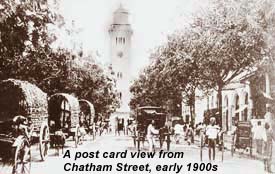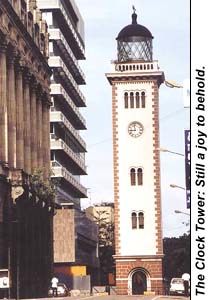 |
 11th OCtober 1998 |
Front Page| |
Time stands still amidst the bustleThe arrow of the weathercock pointed defiantly into the sunset, while the hands of the clock below it were parked, permanently or so it seemed when I saw it at 10.10. It is the hour of watches and clocks when they are depicted in advertisements but represents time standing still in the heart of Colombo.
Within a stone's throw of it is that negothic pile, the General Post Office building reflecting the glories of a long lost Empire and, opposite that, the Governor's residence now known as President's House. Beyond is what used to be the Colonial Secretary's office and Government Printery, now the off-limits building housing the Ministries of Defence and Foreign Affairs. This is an area of Colombo rich in forgotten monuments to Sri Lanka's development. How many visitors ever notice the statue lurking in the corner, almost obscured by the overhanging branches of trees in need of pruning? The statue commemorates Sir Edward Barnes, the Governor who, in the 1820s, pushed through an island-wide programme of road building. All road distances in the island from and to Colombo are measured from that monument. The Clock Tower is within yards (or metres to acknowledge modernity) of the reckoning. Curiously, it seems to have become a Clock Tower late in its existence. It was initially a lighthouse. That it was built for that purpose could cause the strolling stranger, as well as Colombo's denizens, to pause for thought. How could this tower hemmed in by buildings with pretensions as skyscrapers as well as by colonial edifices, standing ten minutes walk from the seashore, ever have served as a lighthouse? That it did is overwhelming evidence of the changing times and of Colombo's burgeoning skyline. The lighthouse was built in 1857, ten years before steam trains and railways came to the island, ten years before the first field of tea was planted, and 35 years before electricity lit up Colombo. The building was originally proposed in 1816 but it was not until Governor Sir Henry Ward vigorously pursued a programme of public works that it was constructed. His wife designed the tower. An early example of jobs for the girls, perhaps. The lighthouse, lit by kerosene oil, stood as a shining sentinel guiding seafarers safely to harbour for nearly a century. Then, in 1954 when it was no longer clearly visible from the sea, its function was taken over by the lighthouse on the seashore at Galle Buck. In 1906, an earnest observer arriving by ship commented: "The most conspicuous object as the breakwater is neared is the white-washed lighthouse, standing on the most elevated part of Fort division." In the meticulous language of Edwardian days, the visitor explains that, "The revolving dioptric white light at the summit, standing at a height of 132 feet above sea level, and showing at night in a triple flash at intervals of 30 seconds, is a safe beacon for ships at sea, being visible at a distance of 17 miles in clear weather."
How, then, the clock, whose four faces can be seen from the four points of the compass? In his book, the Administration of Sir Henry Ward, S.V. Balasingham states that the clock was ordered in 1816 and lay in the Commissariat Stores for 40 years. Jan Baldwin, in her sketchbook called Colombo Heritage records that the clock itself was commissioned in 1872. She adds that the four dials are built to a standard British design such as "can be seen in numerous other Town Halls and Railway Stations throughout the world from Melbourne to Pimlico." Today although, it no longer guides ships to harbour, the Clock Tower is a landmark that has withstood the impact of city planning, or lack of it, as well as of explosions. With care, Lady Ward's unique 19th century monument could remain a joy to Colombo's citizens and visitors in the 21st century and beyond. |
||
 |
More Plus * We've not forgotten you
Front Page| News/Comment| Editorial/Opinion| Business| Sports | Mirror Magazine |
|
 |
Please send your comments and suggestions on this web site to |
|
 A
stranger strolling along the erstwhile Queen Street, now Janadhipathi Mawatha,
from the shores of the Indian Ocean, would remark not on damaged buildings
but on the resolute bastions remaining from colonial days. The former Mercantile
Bank, and the building that, in the 1870s, housed the commercial enterprise
of H.W. Cave, are opposite each other at the head of Chatham Street. Most
impressive, though, is the Clock Tower at the junction of Chatham Street
and Queen's Street, a visible, accessible reminder of the 19th century.
A
stranger strolling along the erstwhile Queen Street, now Janadhipathi Mawatha,
from the shores of the Indian Ocean, would remark not on damaged buildings
but on the resolute bastions remaining from colonial days. The former Mercantile
Bank, and the building that, in the 1870s, housed the commercial enterprise
of H.W. Cave, are opposite each other at the head of Chatham Street. Most
impressive, though, is the Clock Tower at the junction of Chatham Street
and Queen's Street, a visible, accessible reminder of the 19th century.